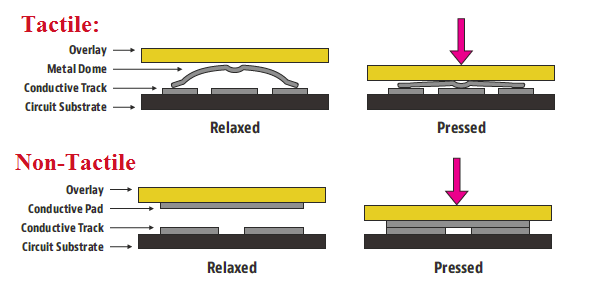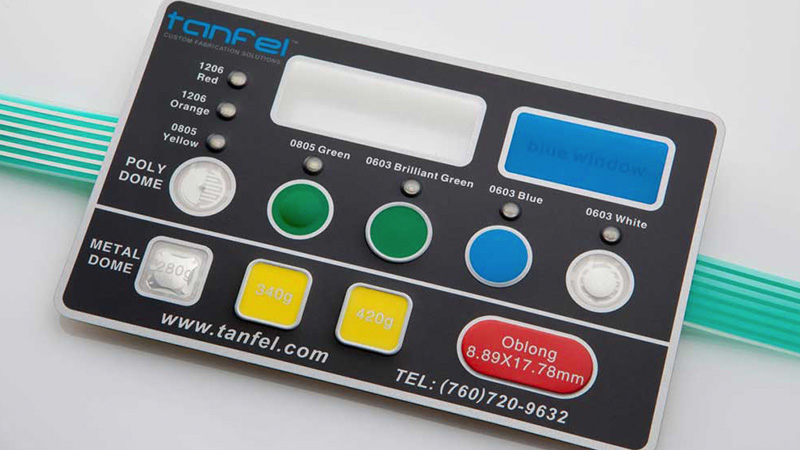Why Membrane Switches Are Gaining Popularity in the Automotive Industry
Why Membrane Switches Are Gaining Popularity in the Automotive Industry
Blog Article
Recognizing the Importance of Membrane Switches in Customer Interfaces
Membrane buttons are essential elements in the layout of effective customer interfaces, facilitating not only capability but also enhancing aesthetic charm and customer communication. As we check out the different advantages and future trends linked with Membrane technology, it ends up being clear that these switches are extra than just components; they stand for a merging of innovation and practicality.
What Are Membrane Switches?
The spacer layer, which includes adhesive residential or commercial properties, enables the separation of the circuit layer from the overlay, making sure that the switch continues to be in a non-activated state until pressed. When pressure is applied to the overlay, it presses the spacer layer, connecting the space and completing the circuit in the underlying layer. This layout not just decreases the physical area required for typical mechanical buttons however also enhances the resilience of the device, as Membrane buttons are normally resistant to dust, moisture, and various other environmental factors.
Typically discovered in applications ranging from customer electronics to clinical gadgets, Membrane buttons are indispensable to contemporary technology, providing a effective and easy to use interface that aligns with modern style demands.
Benefits of Membrane Buttons
While various switch modern technologies exist, Membrane Switches offer unique advantages that make them especially preferable in numerous applications. Among the main advantages of Membrane switches is their compact layout, which enables space-saving implementations in tools where real estate is restricted. Their slim profile not only boosts visual allure however also facilitates light-weight building and construction.
Another significant advantage is their resistance to environmental elements. Membrane buttons are generally secured versus wetness, dirt, and contaminants, making them ideal for usage in demanding environments, such as clinical devices and commercial tools. This sturdiness extends the life-span of the switch, reducing maintenance costs and improving dependability.
In addition, Membrane buttons can be personalized to fulfill specific design demands, including one-of-a-kind graphics and colors that enhance individual interaction. Their responsive comments choices can additionally be tailored to give a satisfying user experience. Additionally, Membrane switches are cost-efficient, especially in high-volume applications, as they can be generated efficiently.
Applications in Different Industries

In the consumer electronic devices market, Membrane switches are common in reference devices such as microwaves, washing makers, and remotes. Their responsive feedback and aesthetic alternatives boost user experience while offering a smooth, contemporary look. Additionally, automotive suppliers use Membrane switches in dashboard controls and infotainment systems, where space is limited, and customer interaction is essential.
Additionally, the industrial market leverages Membrane buttons in control panels for equipment and devices, permitting intuitive procedure in frequently rough environments. Their resistance to chemicals and dampness ensures durability and reliability in these applications. In general, the adaptability of Membrane click over here now Switches adds considerably to their prevalent use, making them vital in various technological domain names.
Layout Factors To Consider for Membrane Switches

When designing Membrane buttons, a number of crucial factors to consider must be taken into consideration to make sure optimum capability and user experience. The choice of materials is critical; selecting resilient, top quality substrates can enhance the switch's longevity and resistance to environmental factors such as moisture and temperature level fluctuations.
Secondly, the style of the visuals overlay need to focus on quality and simplicity of use. Icons and text have to be understandable, and the format must assist in user-friendly interaction (membrane switches). Furthermore, responsive feedback is essential; integrating a tactile dome or various other systems can improve the user experience by giving physical verification of activation
One more important variable is the switch's electric performance. Designers should guarantee that the conductive traces are correctly created to lessen resistance and avoid signal disturbance. This includes evaluating the called for actuation pressure and making sure compatibility with the digital parts they will interface with.

Future Patterns in Membrane Technology
As innovation continues to breakthrough, Membrane buttons are positioned to advance substantially, driven by technologies in materials and manufacturing techniques. One arising fad is the incorporation of sophisticated products, such as conductive inks and versatile substratums, which enhance toughness and lower the overall official source weight of Membrane buttons. These products not just improve the tactile reaction yet additionally enable the design of switches that can hold up against harsher ecological conditions.
Additionally, the combination of touch-sensitive modern technologies is changing conventional Membrane Switches into even more interactive customer interfaces. Capacitive touch sensing units installed within Membrane button panels can provide an extra responsive and instinctive user experience, lining up with the growing need for streamlined, modern-day designs in customer electronic devices.
In addition, developments in printing methods, such as digital and 3D printing, make it possible for quick prototyping and modification of Membrane switches. This flexibility allows manufacturers to respond more promptly to market needs and customer preferences.
Finally, sustainability is becoming a significant focus, with manufacturers discovering green products and processes. As these trends unravel, the future of Membrane technology assures boosted performance, aesthetic appeal, and environmental duty, solidifying their function in advanced interface across various sectors.
Verdict
Finally, Membrane Switches stand for a crucial component in the design of interface, integrating functionality with visual versatility. Their benefits, consisting of resilience and resistance to ecological elements, make them appropriate for diverse applications across numerous industries. Thoughtful layout factors to consider boost user communication and experience. As developments in innovation proceed, the evolution of Membrane switches is anticipated to additional improve interface, driving development and boosting functionality in an increasingly complicated technological landscape.
Membrane switches are important parts in the design of efficient customer interfaces, assisting in not only functionality but likewise improving visual appeal and individual communication.Membrane Switches serve as a crucial part in various user interfaces, assisting in a smooth communication between individuals and digital devices.While numerous button technologies exist, Membrane Switches deal distinctive benefits that make them particularly desirable in different applications.In addition, Membrane buttons can be personalized to meet certain design needs, integrating unique graphics and colors that boost individual interaction.In final thought, Membrane Switches represent a vital component in the layout of customer interfaces, incorporating capability with visual flexibility.
Report this page